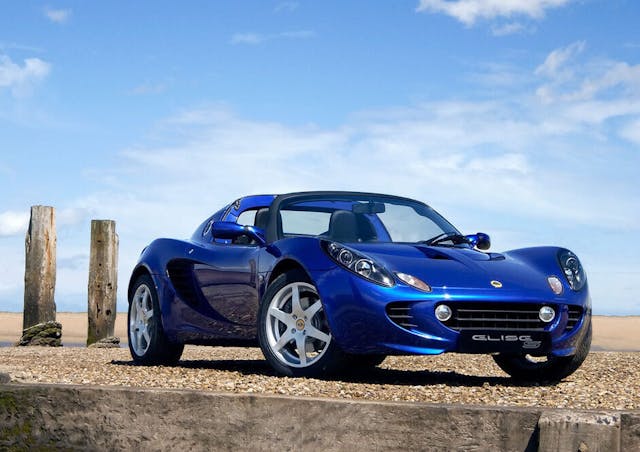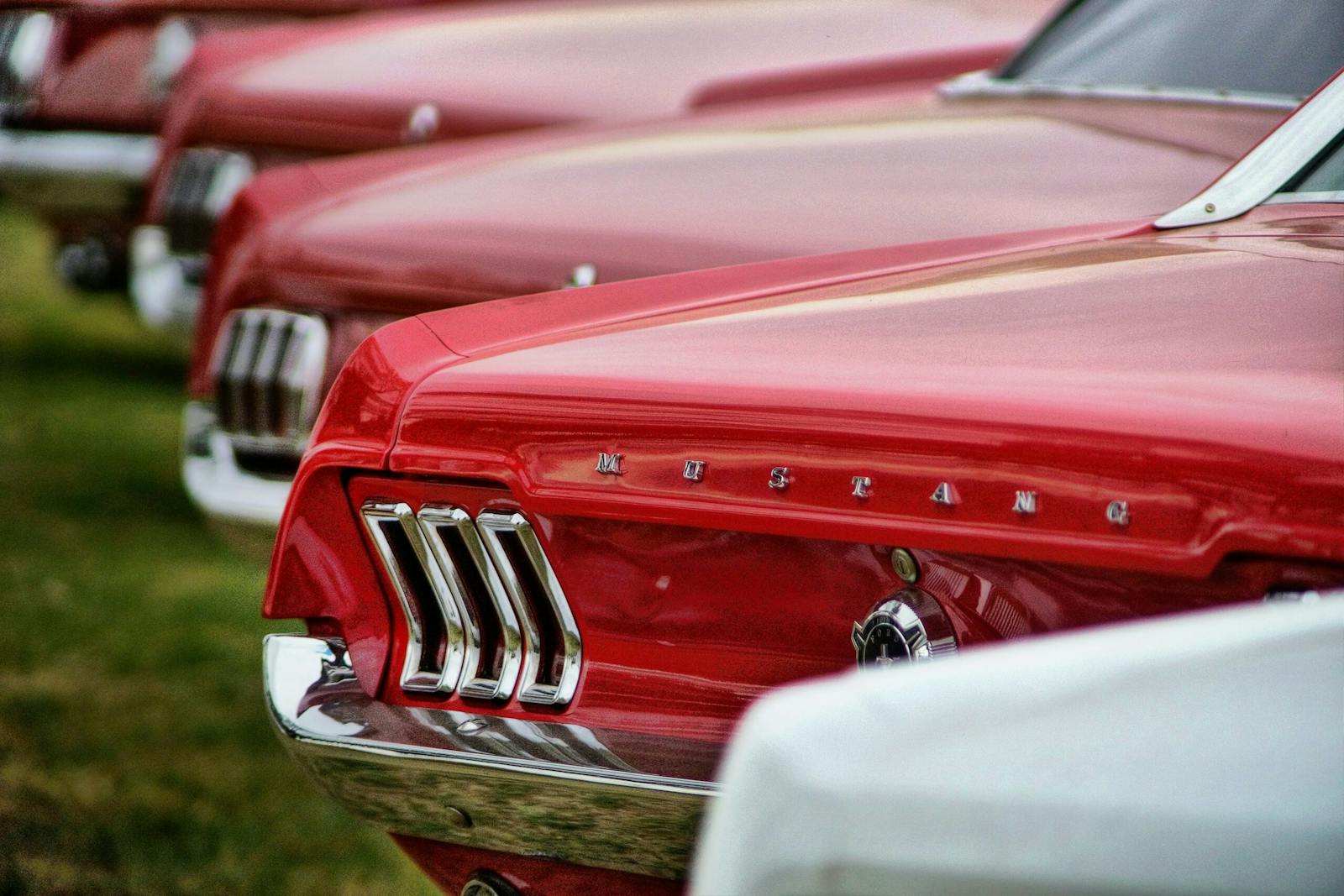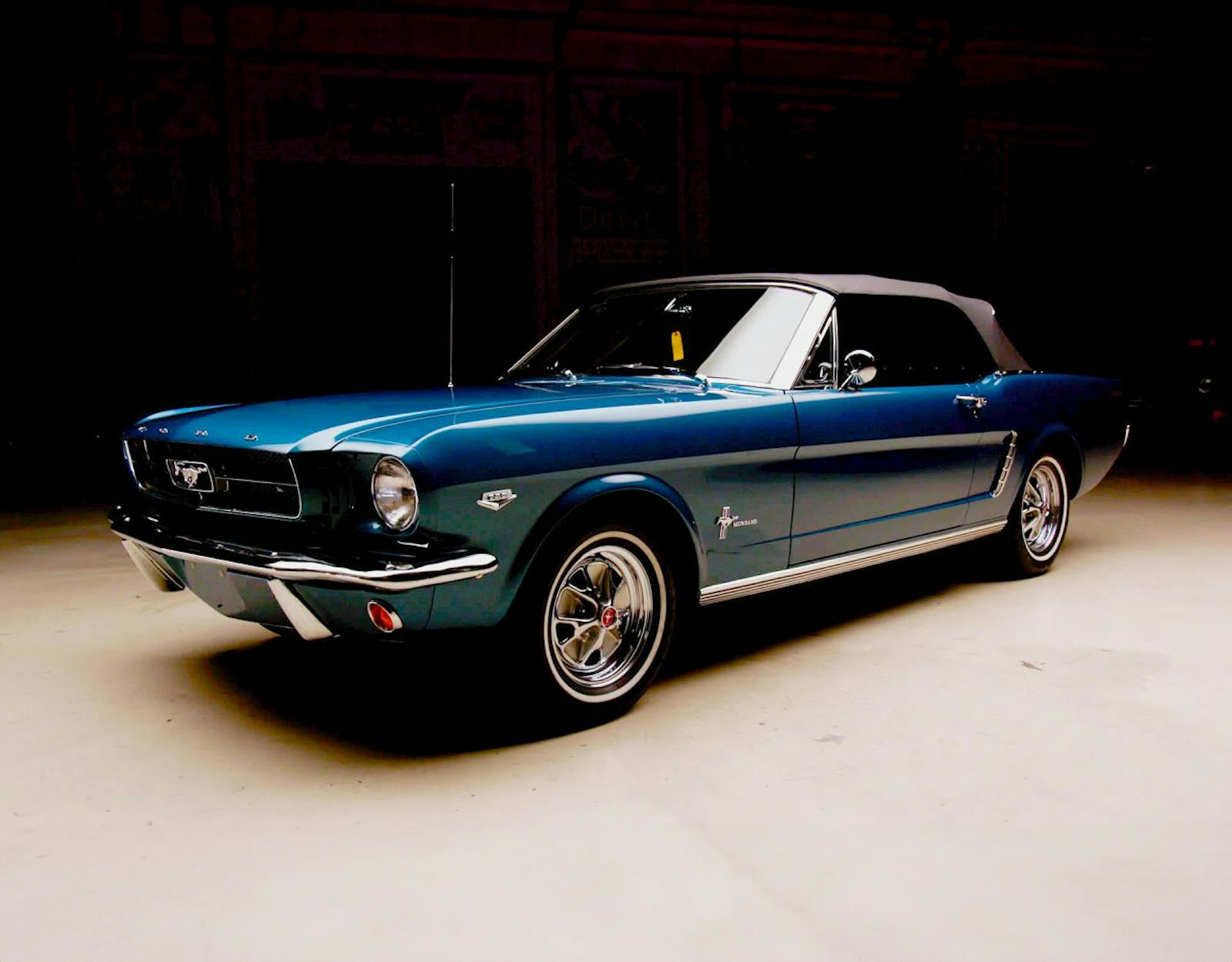Lotus’ pocket-sized supercar is still (somewhat) affordable
Want a better understanding of what’s driving collector-car values? Sign up for the Hagerty Insider newsletter.
In 2005, I was 16 years old and already a freak for Lotuses. My eyes devoured books and magazines on them. My thumbs drove them on Forza Motorsport and Gran Turismo 3. I watched Pretty Woman for Richard Gere’s Esprit, not Julia Roberts, and The Spy Who Loved Me for the Lotus submarine, not the shootouts.
2005 also just happened to be when the most exciting new Lotus in a generation—the Elise—finally arrived in the United States. It looked great, like an angry muscle-bound insect. It sounded great, almost like a big sport bike. And according to Road & Track it drove great, too, with a “giant-threatening velocity … everything else feels imprecise, heavy and slow.”
The Elise also listed for only about 40 grand, which at that time was only a little more than an S2000. It was a lot less than a Boxster. And a lot quicker than both.

The first Elise I ever saw in person was some time that fall, at a car event near Houston. It was Nightfall Blue over black. The owner and I chatted. He wasn’t stupid enough to let this long-haired, teenage stranger drive it, but we did go for a ride. It probably lasted three minutes and never clocked anything over 50 mph, but a little car can make a big impression.
So, years later after I had done some living and saving (and cut my hair), I spotted a 2005 Elise at a good time at a good price, had an “if not now, then never” moment, and bought it.
I’ll admit that this purchase was well-timed and that Elises have gotten significantly more expensive than when I bought mine. But I’ll also probably never sell it, and even at their current all-time high values, these little English pocket-rockets offer a unique, rewarding experience that doesn’t necessarily break the bank.
What they are
By the time American buyers first got a crack at the Elise, the model had already been around nearly a decade and ushered in a renaissance for perennially cash-strapped Lotus. Initially intended as a limited-run vehicle to promote Lotus Engineering (the part of the company that actually made money), the Elise debuted a patented frame made of bonded extruded aluminum. It’s light, strong and, unlike the steel backbone of Lotuses past, not prone to rust.
Cutting-edge chassis aside, the rest of the car was back to basics for Lotus. The revived Elan M100 was a front-drive failure and the Esprit was getting bulkier, but this new car had refreshingly small dimensions, fiberglass bodywork, a no-frills interior, and a small, smiley-faced grille. These were the days when Romano Artioli, who also owned Bugatti, was the boss at Lotus. He kept the Lotus tradition of road cars starting with the letter “E,” but gave it a personal touch, naming it after his granddaughter Elisa.

When it hit showrooms, the Elise struck just the right balance between hardcore roadster and usable, reasonably priced driver, finding favor with enthusiasts and the press. It sold well, and a track-focused model called the Exige soon followed. Versions of the Elise’s brilliant bonded/extruded aluminum chassis would eventually form the basis of other sports cars like the Hennessey Venom, Opel Speedster, Vauxhall VX220, and the original Tesla Roadster.
A new and improved Series 2 version debuted in 2001 to comply with fresh European crash regulations, but its airbags still didn’t comply with U.S. rules. Four years later, though, the feds granted Lotus an exemption (thanks, NHTSA!) and just as the Esprit was bowing out, Lotus started taking orders for its North American, aka “Federal” version of the Elise.
While Rover K-Series engines propelled earlier Elises, the ones we got are powered by Toyota’s 1.8-liter 2ZZ-GE dual overhead cam four-cylinder mated to a six-speed manual transmission. Those who speak Toyota might remember that the 2ZZ also powered very un-sporty A-to-B-mobiles like the Corolla and even the Pontiac Vibe/Toyota Matrix. The 2ZZ-GE version in the Elise, though, has a Yamaha-designed twin-cam cylinder head and came straight out of the Celica GT-S, mounted transversely behind the cabin and featuring a revised intake and exhaust plus a Lotus-tuned ECU for 190 horsepower and 138 lb-ft of torque.
Sure, those were shoulder-shrug numbers even in 2005, but that aluminum Toyota four-banger only has about a ton worth of car to push around. A 2005 Miata weighs over 400 pounds more.
Most Elises sold in the U.S. came with a Touring package that added such wild extravagances as leather seats, power windows, carpets, and more sound deadening. An available Sport package added stiffer springs and height-adjustable shocks. The removable hardtop was another popular option, while a removable rectangular cloth soft top that (awkwardly) snaps in at each corner came standard.

The Elise was with us for just seven years, and it didn’t change a whole lot in that time. For 2006, Lotus added an available limited-slip differential, traction control, and A/C delete, as well as drive-by-wire throttle and LED taillights. Some cars also got dual oil coolers. An Exige arrived for 2006 as well, powered by the same 190-hp engine but with a fixed roof and rear-mounted wing.
Then, a mild refresh in 2008 revised the gauge cluster and added a cupholder on the Touring package. Oh, the luxury! The biggest news for 2008, though, was an Elise SC model that force-fed the Toyota four with a Roots-type supercharger, boosting its numbers to 220 hp and 158 lb-ft.
The biggest change came just in time for the model to leave the United States market. In August of 2011, Lotus’ lucky NHTSA waiver expired, so as a going-away gift from Lotus, the U.S. received the facelifted Series 3 version for that year only. It would soldier on in the UK/Europe until 2022 and ensure the Elise’s place as the best-selling Lotus model ever. RIP. The Elise’s larger and more mature sibling, the Evora, kept the Lotus flag planted on American shores.
What they’re worth
Lotus sold over 6000 Elises and Exiges over here. About half of those are 2005 Elises, so they are by far the easiest to find. Sales only dropped from there. The later an Elise’s model year, the rarer the car.
But while the ultra-rare 2011 models (just 128 U.S. cars, according to Lotus Talk) as well as special editions like the 72D, California Edition, and 60th Anniversary Edition have always commanded a hefty premium, they were market outliers. For a long time most Elises, almost regardless of options, mileage, and color, sold for around the same price. For a decent example, somewhere around 30 grand was the going rate for years. Sure, these are impractical cars with limited appeal, but an Elise was so much bang for an enthusiast’s buck.
Then there was the pandemic boom. Fun-to-drive cars of all types were in high demand. The performance-bargain Elise couldn’t stay secret forever, and I’m surprised it stayed quiet as long as it did. In late 2020/early 2021 sale prices really started to tick up, more so for #1 (Concours) and #2 (Excellent) condition cars. Over the last three years, the median #2 value for Elises is up 55 percent, and currently sits at $57,600 for base cars or $64,900 for Elise SCs. No, that’s not cheap, but driver-quality base Elises can still be had for under $40K.
The more track-oriented Exiges, particularly the supercharged versions, are significantly rarer and a lot more expensive, with the best of them knocking at the door of six figures.
Then there’s the curious underbelly of the Elise market—cars with rebuilt titles. Normally when we find a sports car with a rebuilt or salvage title for sale, we conjure up drastic scenarios: a wreck after someone ran from the fuzz, or a poor car getting washed away in a hurricane only to be shoddily cleaned up and thrown onto a shady car lot.
With the Elise, rebuilt titles are a little more complicated.
The front and rear “clamshells” of the Elise are really just two giant pieces of bodywork. They’re easy to damage but very difficult (i.e. expensive) to repair or repaint. Add in the fact that the Lotus is a specialty, semi-exotic car, and now you’ve got insurance companies totaling Elises for fender-benders. Thankfully, hundreds of these perfectly usable Elises with one wheel in the grave have been rescued by owners as well as specialists like Wire Wheel Sports Cars.
Buying one of these rebuilt-title Elises is a cost-effective way to get into a Lotus if you’re looking for one to drive, enjoy, or track rather than collect, but it’s best to be extra careful when buying a rescue. Have a pre-purchase inspection done by someone specifically familiar with Elises. If the monocoque was ever damaged, the car is essentially toast.
Modifications are quite common, particularly ones that give the engine more oomph. Some owners have even swapped out the Toyota drivetrain in favor of Honda’s slightly larger K20 engine. And, surprise, many Elises have also been at least casually tracked or autocrossed, and the usual rules for buying a hard-driven car apply. Camshaft wiping (excessive camshaft lobe wear) is a known issue on the 2ZZ motor, and some Elises had a recall on oil-cooler lines. The factory radio that came in the Elise sucked. By now, many owners have replaced theirs with an aftermarket one that usually also sucks.
Appreciation has slowed down after that COVID-era spike, but Elises have staying power. The rate of insurance quotes for Elises among millennials is twice as high as the average collector car. And given that almost nobody is building affordable, bare-bones, driver-focused cars anymore, a relatively modern, fun, exotic-looking one like the Elise has a long-term appeal.

What they’re like to live with
On balance, the Elise is a great car with plenty of caveats. Many of the old Lotus pitfalls were woefully unreliable engines, rusty chassis, and interiors that disintegrated. But the Elise is aluminum, so it doesn’t rust. It has a Toyota engine that doesn’t leak. And it barely even has an interior, so there’s nothing to disintegrate.
Speaking of the interior, though, good luck trying to look suave getting in or out of an Elise. At 6’2” I fit just fine in mine, but getting there is a different story. First off, the sills are high and wide, about 15 inches off the ground, 4 inches wide at their narrowest and 8 inches at their widest. From the bottom of the door to the roof is only about 28 inches high, so it’s a small and awkward space through which to squeeze.
To this day I haven’t figured out how to get in without having to brush my size 13 feet across the dash and have learned to just live with the scuffs.

There’s no glovebox, just a good-old fashioned shelf made out of aluminum. If you don’t want your stuff to slide around, Lotus provided a stupid little cargo net between the seats. The rear trunk holds a week’s worth of groceries (if you’re single) or two small overnight bags (if you’re not). There is no frunk in an Elise.
The car’s worst enemy is a steep driveway, and if you’re driving with the soft-top on and happen to catch some rain, keep in mind that getting a little wet is a feature, not a bug.
Check this out:

Way to CYA, guys! It’s not like it rains a lot in England or anything.
As for reliability, the drivetrain is Toyota but the rest of the car isn’t, so finding parts or service isn’t as straightforward as it is on more common cars. The engine bay is also fairly cramped. Oh, and the air conditioning only kind of works, even at the best of times.
Those are pretty much all the asterisks.
Now, to the good stuff. Most of the bad is easily eclipsed by the good that comes behind the wheel. Elises strike a good balance of driving almost like a track car while having real-world creature comforts, however imperfect, like power windows and A/C. It’s not a numbers car, but like any tiny, low-slung sports car, it feels plenty fast and gives a nice little shove and shout when it comes on cam at 6200 rpm.
Steering is unassisted but commendably light, even when parking, and the turns are where any Lotus shines. There’s no arguing with physics, so chucking around a car that weighs 2000 pounds feels a lot different (and better) than one that weighs 3500. Turn-in is intoxicating and immediate. The rate at which this car changes direction, combined with the ample grip, provides never-ending entertainment. Driving an Elise will spoil the experience of plenty of other performance cars, which may start to feel a bit piggish in comparison.

It is not a road-trip car, but a few hours in the cabin is doable. Despite their stiffness, the seats are well-designed and reasonably comfortable. (Swapping in Elise seats is actually a common upgrade to certain other classic cars, and even to Miatas.) Suspension is stiff and not pothole-friendly, but it isn’t jarring, either. Provided you’re brave enough to commute among the SUVs and willing to do the yoga poses to get in and out of an Elise, daily driving one is possible, and there are cars out there with over 100,000 miles.
These cars aren’t the surprising steal they used to be, and that’s too bad. The world could use more cheap sports cars. Unfortunately, though, the world isn’t getting many more cheap sports cars, and even at its current values the Lotus Elise is a great value. Quick, beautiful, relatively reliable, always entertaining, and a little bit eccentric, it’s an attainable dream car. Even if you weren’t 16 when it came out.
***
Check out the Hagerty Media homepage so you don’t miss a single story, or better yet, bookmark it. To get our best stories delivered right to your inbox, subscribe to our newsletters.
Via Hagerty Insider



Lotus, is a flower. Has many petals, hence Lotus, plural. Lotu is one petal.
The 2ZZGE engine is EXACTLY the same as that used in the Corolla XRS, Matrix XRS and Pontiac Vibe GT. Also, the 2006 model got throttle by wire instead of the throttle cable of the 2005. It is the most responsive throttle by wire I have ever experienced. You would think there was a cable.
My 2006 Elise is insured by Hagerty, as is my Evora 400, and a Europa for that matter.
Bought my saffron yellow 2005 the week of the Covid shutdown 3 years ago. I’ve put 18K miles on it since purchase. Now it has over 112K miles and very reliable. I made some simple improvements to the HVAC ductwork and the car cools comfortably in 98 degree weather. Longest trip was from SF Bay Area to SLC for the Lotus Owners Group festivities in 2021, then the Reno Air Races, a 10 day trip including a track day at Utah Motorsports Park. These are brilliant drivers’ cars and very livable with their simplicity.
Who has the tooling? Why not Eliserham the thing under the Small Volume Manufacturer exemption?
My 2003 Vibe GT was bought new back in the day because of that engine. Lots of fun to drive–better like to shift a lot–and I topped 140 with it quite easily. It got traded in for 05 CTS-V.